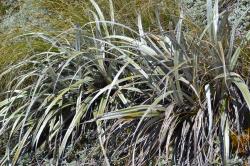- Taxon
- Gallery
- = Astelia nervosa var. montana Kirk ex Cheeseman, Man. New Zealand Fl. 714 (1906)
- ≡ Astelia montana (Kirk ex Cheeseman) Cockayne, Rep. Bot. Survey Tongariro Natl. Park 36 (1908) nom. illeg.
- = Astelia cockaynei Cheeseman, Trans. & Proc. New Zealand Inst. 54: 565 (1923) – as Cockaynei
Tufted plants often forming considerable colonies. Stem 1–2–(3) cm. diam. Lvs 50–150–(200) × 2–4–(6) cm., arched stiffly outwards and of firm texture, strongly keeled above the sheath; sheath to 8 cm. wide at base, thickly clad in scales; lamina adaxially green and covered with scales that form a continuous smooth transparent pellicle or are in parts or overall ruffled up into a white shaggy fur that obscures the green colour; abaxial surface with persistent indumentum of white or bronzed scales overlying a thin, hardly felted layer of wool and with lateral costae (1–2 on each side of midrib) not prominent. Infl. erect, most parts covered with scales; peduncle about = panicle, spathes longer; racemes us. < 12, all single or 2–3 in each of the 1–3 lowest spathes. Fls from light greenish fawn to very dark maroon, us. pedicellate and well spaced on relatively slender axes; tepals 4–6 × 2.5–4.5 mm., widely spreading in ♂, in ♀ curling outwards from deep per.-tube. Ovary 3-locular, pyriform. Fr. 8–15 × 5–8 mm., broadly ovate, various shades of orange to almost red, ± surrounded, at least until fully ripe, by ± fleshy scaly cup developed from per. n = 105.
[From: Moore and Edgar (1970) Flora of New Zealand. Volume 2.]
Flowering: Oct.–Dec.; Fruiting: Feb.–May.




